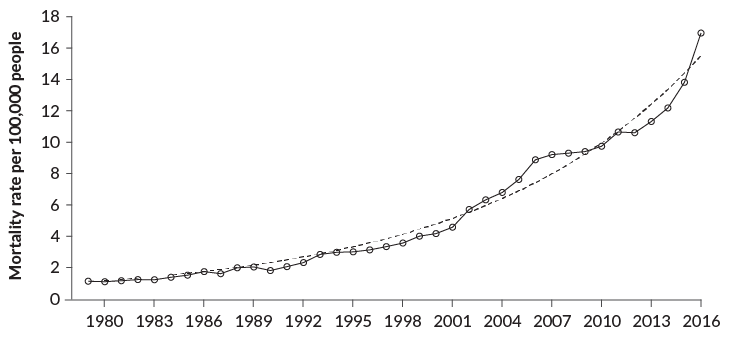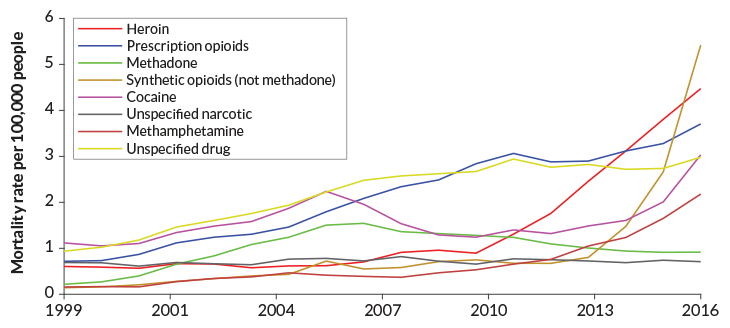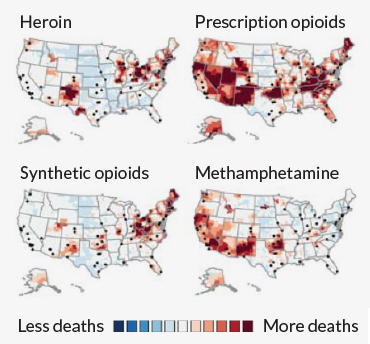Drug overdose deaths in America are rising exponentially
The problem is bigger than any one drug, researchers say

NOT JUST ONE The drug overdose problem is bigger than any one drug, according to a new analysis of the overdose epidemic from 1979 to 2016.
Leszek Czerwonka/Shutterstock
- More than 2 years ago
Even as the country’s attention is focused on the ongoing opioid epidemic, a new study shows that the United States has had a wide-ranging drug overdose problem for decades, and it’s growing ever worse.
Analyzing nearly 600,000 accidental drug poisoning deaths from 1979 to 2016 shows that the country has seen an exponential rise in these cases, with the number of deaths doubling approximately every nine years, researchers report in the Sept. 21 Science. More than 63,600 Americans died from all drug overdoses in 2016, according to the Centers for Disease Control and Prevention.
Numbers of accidental overdose deaths due to individual drugs, such as heroin or methamphetamine, have varied during the 38-year time period. But combining the data, from the National Vital Statistics System, produces a clear — and troubling — pattern, one that portends that the overall overdose epidemic will continue in the future, the researchers conclude.
“We need to focus on the entire epidemic,” not just a particular drug, to understand what’s driving the continued growth in drug overdose deaths, says coauthor Hawre Jalal, a health policy researcher at the University of Pittsburgh. “Without looking at the entire picture, we might not be hitting the root causes.”
All together
Looking at mortality rates from all drugs together, a clear pattern emerges. This exponential growth curve (dotted line) suggests the overall drug overdose epidemic will continue to grow.
Overdose deaths due to all drugs, 1979–2016

Synthetic opioids, such as fentanyl, currently top the list of drugs that cause the most overdose fatalities in the United States — there were 5.4 of these deaths per 100,000 people, the researchers found based on data from all 50 states. But the rise and fall of different drugs contributing to the overdose epidemic over the past four decades makes it difficult to predict what drug will be deadliest next, the researchers say.
A new drug could emerge to top the list. “I’m worried that we might not be prepared enough for the next one,” Jalal says. “What’s going to happen after fentanyl?”
Pitching in
Death rates from unintentional overdoses from individual drugs have generally risen over the years, but the popularity of some drugs, such as cocaine, has dipped from time to time.
Overdose deaths per selected drugs, 1999–2016

The researchers also identified geographical hot spots in drug overdose deaths in the country over time. For example, heroin-related deaths used to be associated with large cities but have now spread more widely, notably in the Southwest and Northeast. Methamphetamine-related deaths are clustered in the Southwest and up the West Coast, the researchers found, while hot spots for prescription opioid deaths cover large swaths of the country.
Data from the most recent years show that “almost every region in the U.S. is a hot spot for mortality from one or more drugs,” says Kathleen Stewart, a geographic information scientist at the University of Maryland in College Park. The research also highlights changing rural and urban trends, with overall death rates in rural counties increasing in more recent years and becoming less clustered in urban centers, she says.
Too hot
Researchers created maps that compared the hot spots for overdose death rates from individual drugs relative to all drugs over the time period studied. For instance, from 2012 to 2016, prescription opioids hot spots stretched pretty much from coast to coast, while heroin and synthetic opioids (other than methadone) overdose deaths were largely concentrated in the Northeast and hot spots for methamphetamine overdoses popped up predominantly in the Southwest.
Hot spots of fatal overdoses for selected drugs, 2012–2016


It’s not clear what’s fueling the United States’ long-running drug overdose problem. There are a number of social and psychological factors that are probably influencing overdoses, Jalal says, such as widespread despair and the breakdown of communities as well as changes in the way drugs are manufactured.
Understanding how all of the individual components — different drugs, policies, interventions, the licit and illicit markets — at play across the country act together needs investigation, he says.







